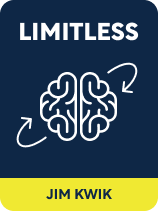

This article is an excerpt from the Shortform book guide to "Limitless" by Jim Kwik. Shortform has the world's best summaries and analyses of books you should be reading.
Like this article? Sign up for a free trial here .
What is the book Limitless by Jim Kwik about? How might you apply the limitless model of learning to your own life?
Limitless by Jim Kwik is a self-help book that discusses meta-learning—that is, learning how to learn. In this book, Kwik teaches you how to quickly and effectively learn about any topic and then how to use that new knowledge to its maximum potential.
Keep reading to learn what Limitless by Jim Kwik is all about.
Limitless by Jim Kwik
Jim Kwik is a teacher, life coach, and motivational speaker. He credits his success to his ongoing studies of meta-learning, and he hopes to share what he’s learned through Limitless.
Kwik’s lessons are based on his own experiences. He suffered a traumatic brain injury at a young age, and from then on he struggled in school. When he went to college, Kwik realized that if he could learn how his own mind worked, he’d be able to learn and use his knowledge more effectively. Today, Kwik is a teacher, life coach, and motivational speaker. He credits his success to his ongoing studies of meta-learning, and he hopes to share what he’s learned through Limitless.
Limitless by Jim Kwik covers five topics:
- Kwik’s model of limitless learning—getting introduced to the main points of Limitless and seeing an overview of his model.
- Mindframe—getting yourself into the right headspace to learn and to make the most of your knowledge.
- Drive—motivating yourself to learn: You have the ability to learn anything; even so, you’ll struggle with any subject unless you give yourself a reason to be interested in it.
- Technique—learning specific practices and strategies to reach your limitless potential, and finding which ones work best for you.
- Action—putting your new limitless learning into practice by making long-term plans and building the life you want.
We Must Learn How to Learn
Most people put artificial limits on their learning: For example, they might think they’re too stupid to learn something, or too old to learn new skills, or just not good at a particular subject.
Kwik designed the limitless model to eliminate those limits. It teaches you how to get into an ideal frame of mind for learning, and then use simple, practical techniques to learn and retain new information.
The Limitless Model
Kwik’s model of limitless learning is based on three components:
- Mindframe: This is about truly believing you have the limitless potential that Kwik discusses, as well as putting yourself into an open and productive frame of mind. In other words: You must believe that you can learn, and you must be ready to learn.
- Drive: Even once you know that you can learn anything in the world, you won’t learn something that doesn’t interest you. Thus, you need to find ways to motivate and convince yourself to put your limitless potential to work.
- Techniques: These are the practices and strategies you’ll use to learn new information quickly, and remember it permanently.
According to Limitless by Jim Kwik, you have to master each of the three components for the limitless model to work correctly because they’re interdependent.
| Harness Your Thoughts, Feelings, and Surroundings Kwik’s method for learning parallels Chip and Dan Heath’s method of reaching any goal in Switch. However, instead of components or stages, the Heaths describe three driving factors in your life that you must harness (a method that may be easier for some people to visualize than Kwik’s): Your rational side (Kwik’s Mindframe) Your emotional side (Kwik’s Drive) Your lifestyle and habits (Kwik’s Techniques) Switch says that when these three parts of yourself are in alignment, you’ll be able to accomplish all of your goals. The Heaths’ main guidelines are: Harness your rational side by giving it clear instructions. Create a goal with a clear endpoint and firm rules about how you will pursue it. For example, if you’re trying to become a more well-rounded reader, perhaps make a rule that you must read one non-fiction book between fiction books (and vice versa). You might also find it helpful to find people who have accomplished what you’re trying to do, and emulate their methods. Harness your emotional side by appealing to feelings (instead of logic) and removing obstacles. To fully motivate yourself, you need strong emotions driving you to make a change (either positive emotions like hope and excitement, or negative emotions like shame and guilt). However, you also need to cater to your emotional side’s desire for quick gratification; that means finding opportunities to celebrate small victories, and convincing yourself that your goal isn’t as far off and difficult as it seems. Harness your environment by immersing yourself in helpful routines, environments, and groups. Design your environment to support good habits and make bad ones inconvenient. For example, if you’re trying to lose weight, you could get a gym buddy (or hire a personal trainer) whom you’d have to call to cancel if you want to skip the gym that day. You might also make a rule that you can only order pizza if you go to the pizzeria yourself and wait while they make it, instead of ordering delivery. |
| One thing that the model in Limitless by Jim Kwik doesn’t include is the neuroscience behind how learning works. Dr. Barbara Oakley (A Mind for Numbers), a professor of engineering at Oakland University, has gathered a huge following by teaching about that exact topic. According to Dr. Oakley, your mind groups related information into what she calls chunks, and then accesses that chunk all at once. As you create new chunks, you’ll naturally build upon old ones and access more and more information at once. For example, if you’re trying to memorize a story, you’d probably start by memorizing the first sentence. As you continue working through the story, each new sentence or paragraph will naturally connect to the ones before, and so you’ll remember more and more of the story at a time. |
Limitless by Jim Kwik presents principles and practices that can lead to success in both your personal life and your career.

———End of Preview———
Like what you just read? Read the rest of the world's best book summary and analysis of Jim Kwik's "Limitless" at Shortform .
Here's what you'll find in our full Limitless summary :
- Jim Kwik's guide to meta-learning: learning how to learn
- How to quickly and effectively learn about any topic
- How to use your new knowledge to its maximum potential






